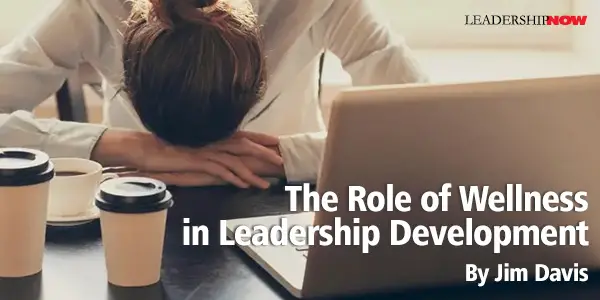 |
 |
06.08.22

The Role of Wellness in Leadership Development
IS IT POSSIBLE that we overlook the role of the body in our professional lives? Habits of health and wellness play a larger role in workplace culture than one might initially think. In a recent article for Northwestern University’s Leadership Magazine, I highlighted a client, “Brian,” who was working his tail off but fell into a state of exhaustion. At first, it was hard to name. He was doing everything he thought he was supposed to. Working late, trying hard, committing fully to his organization and the people around him. Slowly, his motivation waned. He became more irritable and less satisfied with his work; communication broke down, and stressors stacked up. From the article: “he had raised his voice at a coworker, sent an angry message to his wife, and was caught in the fumes of varied frustration. Things seemed to be crumbling around him. By noon he decided to call off for the day. He had not taken a sick day in years. He says he does not remember the drive home, but he does remember making himself some tea and sitting down on the couch. The tea was too hot, so he set it down for a moment. The next thing he remembers is waking up in the dark, laying down now, after an unintentional five-hour nap. He brushed his teeth, went to bed, and slept through the night. The next day he was fine. Simply, Brian was exhausted. Sometimes we use the term ‘exhausted’ to describe a long day, to add emphasis to our fatigue. Brian was actually exhausted – drained of physical and mental capacity. In this state, physical and emotional health fail, as do our relationships and our potential to lead.” Brian’s experience was relatively benign. But when a steady state of exhaustion persists for a career, the outcomes can be far worse. And if the fear of long-term health outcomes is not enough to sway the leader toward prioritizing his or her own wellness, they might want to consider the impact it has on their business. The Impact of Wellness on Workplace Success Brian was part of a leadership team that was focused on strong company culture. We conducted a survey of the leadership team, which catalogs – among other important components of healthy culture – habits of physical health and wellness. As we processed the data, we noticed that one health variable was having a powerful impact on people’s cognitive and emotional state: sleep. We looked closer. We split the group into two categories: Well-Rested (WR) for those with 8+ hours of sleep, and Sleep-Deprived (SD) for those who slept 6.5 hours or fewer. What we found was incredible. Sleep played a major role in KEY areas of the company’s culture: ▪ Negative Stress. Although members of the team were experiencing similar stressors during their workday, the Sleep-Deprived group interpreted those stressors to be 54% more negative than their Well-Rested peers. Same challenge, different perception, and sleep seemed to be a key piece of that difference. ▪ Motivation. The SD group reported 30% lower workplace motivation than the WR group. ▪ Communication. The SD group found it more difficult to maintain optimistic assumptions in communication with their peers, with scores 28% lower than the WR group. Additionally, the WR group found it easier to clarify difficult ideas with their peers than the SD group, reporting scores that were 21% higher than their sleepy peers. Our next step was clear. Before moving on to the complex dynamics of a healthy workplace environment, we had to create goals around sleep health and hygiene. Leaders and teams aim for a leg up on the competition with strategy-based professional development opportunities. Strategy always falls victim to implementation. If a group is not motivated, communicating poorly, and has a negative perception of shared work, then implementation of strategy will surely be challenged… if sleep deprivation is associated with all, then it seems like the first lever to pull. Teaching high-level strategy to a sleep-deprived team is like icing a cake that is not fully baked. Having identified the what (sleep) and why (impacting stress, motivation, and communication), we started in on the how. The results were amazing, if not predictable. When we began tackling individual challenges with sleep, motivation and communication went up almost immediately. Here’s a write-in from one of our team surveys: “Thank you. I didn’t even see [my sleep habits] as a problem. Now that I do and I can work on them I feel better in all areas of my life, especially my work. I’m more patient for sure.” Improving sleep is not a workplace cure-all. There was still plenty of work to do regarding workplace culture and communication. But recognizing the role of physical health and wellness was an important place to start. Next Steps The human condition is not linear. Pulling one lever does not automatically result in the outcome we might want. We are all, leaders and otherwise, in a constant state of skill-building, problem-solving, evaluation, and re-imagination. Health and wellness is one component of our leadership development work. We have multiple methods of maximizing leadership potential for individuals and teams. Our methods have been influenced by the best in the business (Marshall Goldsmith methods, Harvard Business School’s Organizational Development strategies) as well as decades of success implementing these methods. The journey toward improved leadership will not always be easy, but it will always be worth it. 
Posted by Michael McKinney at 06:36 AM
|
BUILD YOUR KNOWLEDGE
 

How to Do Your Start-Up Right STRAIGHT TALK FOR START-UPS 
Grow Your Leadership Skills NEW AND UPCOMING LEADERSHIP BOOKS 
Leadership Minute BITE-SIZE CONCEPTS YOU CAN CHEW ON 
Classic Leadership Books BOOKS TO READ BEFORE YOU LEAD |